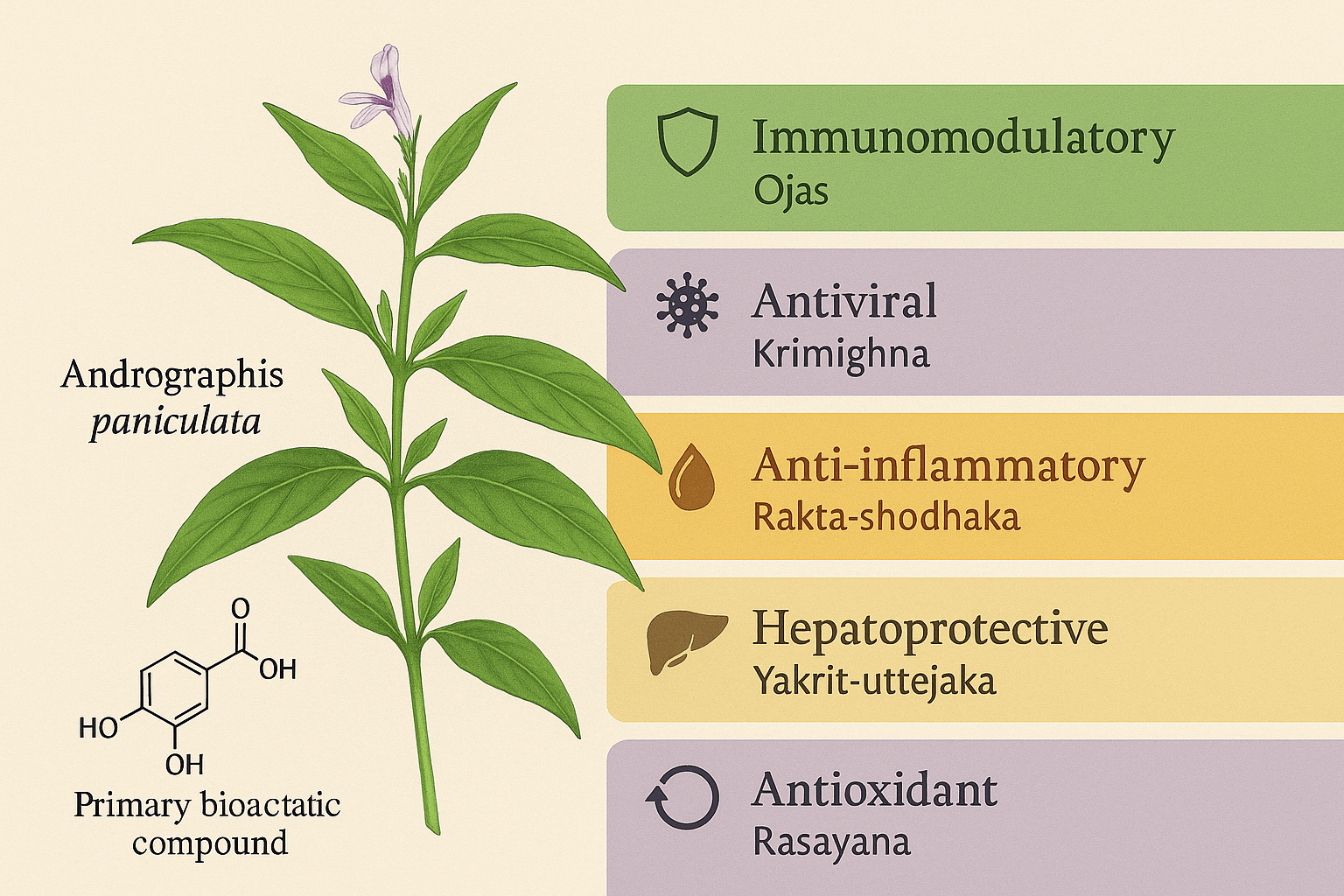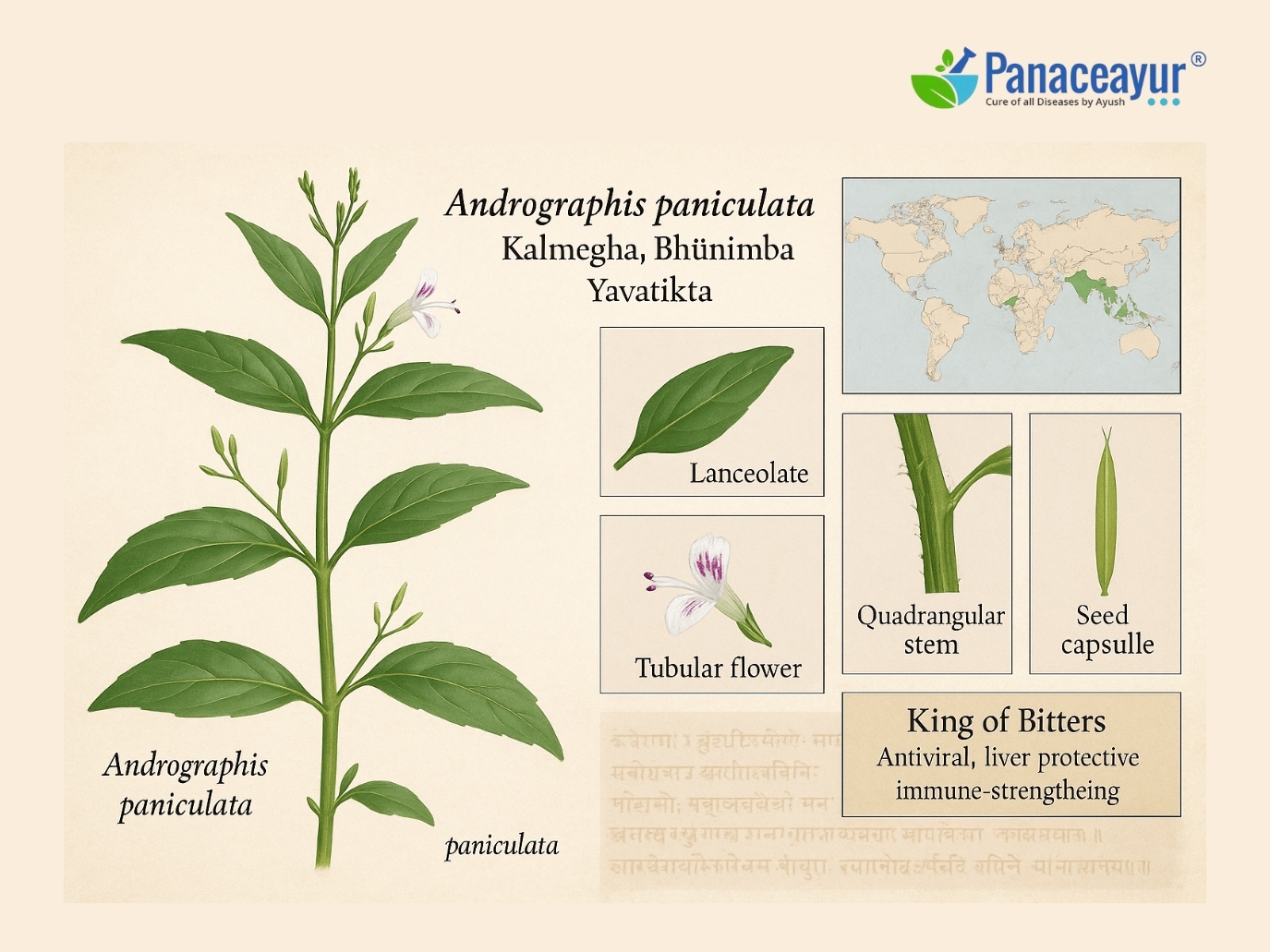- Classical Ayurvedic References and Context
- Phytochemistry and Pharmacognosy
- Broad Therapeutic Spectrum of Kalmegh
- Modern Pharmacological Actions
- Immunomodulatory effects
- Antiviral mechanisms
- Anti-inflammatory pathways
- Hepatoprotective action
- Antioxidant properties
- Etymology and meaning of “King of Bitters”
- Geographical distribution and cultivation patterns
- Historical role in Ayurveda, Siddha, Unani, and folk medicine
- Classical dosage forms and administration
- Modern standardized extract dosage
- Case Studies & Clinical Outcomes
- Herpes simplex virus management
- Chronic hepatitis B support
- Acute febrile illness
- Psoriasis management
- Upper respiratory tract infections
- Mixed infections in immunocompromised patients
- Frequently Asked Questions
- Reference
Botanical identity and taxonomy
Kalmegh (Andrographis paniculata), scientifically identified as Andrographis paniculata, belongs to the family Acanthaceae. It is an annual, erect, and herbaceous plant that grows in tropical and subtropical regions. The taxonomical classification places it under the kingdom Plantae, division Magnoliophyta, class Magnoliopsida, and order Lamiales. It is widely recognized in traditional pharmacopeias for its bitter taste and medicinal potency, and it has been included in both Ayurveda and other Asian traditional systems for centuries.
Sanskrit and regional names (Kalmegha, Bhunimba, Yavatikta)
In Ayurveda, Kalmegh is known by multiple Sanskrit names, each reflecting its medicinal qualities. Kalmegha translates to “dark cloud,” possibly indicating its deep green foliage and strong potency. Bhūnimba means “neem of the earth,” drawing a parallel with neem due to its similar bitterness and healing potential. Yavatikta refers to its pervasive bitterness. In regional languages, it is called Mahatita in Hindi, Kariyat in Malayalam, Nilavembu in Tamil, and Chiretta in Bengali.
Etymology and meaning of “King of Bitters”
The title “King of Bitters” arises from the extremely high concentration of bitter principles present in all parts of the plant, especially the leaves and stems. In Ayurveda, bitterness (tikta rasa) is associated with detoxifying the blood, reducing heat, and controlling inflammatory processes. This intense taste profile has historically led to its preference for cleansing therapies, immune modulation, and management of feverish and toxic states [1].
Geographical distribution and cultivation patterns
Kalmegh is native to India and Sri Lanka but is also cultivated extensively in Bangladesh, Thailand, Malaysia, and Indonesia. It thrives in warm, humid climates and can be grown up to altitudes of 1500 meters. The plant requires well-drained soil, prefers partial to full sunlight, and is generally sown at the onset of the rainy season. Modern cultivation methods have expanded its production to meet increasing demand for herbal medicines, with standardized farming practices ensuring consistent phytochemical content [2].
Morphology – leaf, stem, flower, and seed characteristics
Kalmegh is characterized by a slender, quadrangular, and green stem that can reach 30 to 110 centimeters in height. The leaves are opposite, lanceolate, and dark green, measuring 2 to 12 centimeters in length. Flowers are small, tubular, and white with purple spots, borne in racemes. The fruit is a linear-oblong capsule containing numerous yellowish-brown seeds. Each morphological feature is important in pharmacognostic identification, ensuring the correct species is used in medicinal preparations [3].
Historical role in Ayurveda, Siddha, Unani, and folk medicine
In Ayurveda, Kalmegh has been classified under the tikta varga (bitter group) in the Bhavaprakasha Nighantu and is prescribed in jwara (fevers), yakrit vikara (liver disorders), kustha (skin diseases), and krimi roga (parasitic infections). In Siddha medicine, it is used for fever, snakebite, and digestive stimulation. Unani medicine recognizes it for its cooling, detoxifying, and febrifuge actions. Folk traditions across Southeast Asia employ it for malaria, dysentery, and general convalescence after infectious diseases [4].
Why Kalmegh is relevant in 21st-century viral medicine
The global resurgence of interest in plant-based antivirals has positioned Kalmegh as a leading candidate for integrative treatment strategies. Its main bioactive compound, andrographolide, has demonstrated broad-spectrum antiviral activity, particularly against herpes simplex viruses, cytomegalovirus, hepatitis viruses, and influenza [5]. Additionally, its immunomodulatory effects support both innate and adaptive immune function, making it valuable for chronic viral conditions where immune exhaustion is a concern. The convergence of classical knowledge and modern research reinforces its role in addressing drug resistance, viral latency, and the need for safe, multi-targeted therapies in contemporary medicine.
Classical Ayurvedic References and Context
Botanical identity and taxonomy
Kalmegh, scientifically identified as Andrographis paniculata, belongs to the family Acanthaceae. It is an annual, erect, and herbaceous plant that grows in tropical and subtropical regions. The taxonomical classification places it under the kingdom Plantae, division Magnoliophyta, class Magnoliopsida, and order Lamiales. It is widely recognized in traditional pharmacopeias for its bitter taste and medicinal potency, and it has been included in both Ayurveda and other Asian traditional systems for centuries.
Sanskrit and regional names (Kalmegha, Bhūnimba, Yavatikta)
In Ayurveda, Kalmegh is known by multiple Sanskrit names, each reflecting its medicinal qualities. Kalmegha translates to “dark cloud,” possibly indicating its deep green foliage and strong potency. Bhūnimba means “neem of the earth,” drawing a parallel with neem due to its similar bitterness and healing potential. Yavatikta refers to its pervasive bitterness. In regional languages, it is called Mahatita in Hindi, Kariyat in Malayalam, Nilavembu in Tamil, and Chiretta in Bengali.
Etymology and meaning of “King of Bitters”
The title “King of Bitters” arises from the extremely high concentration of bitter principles present in all parts of the plant, especially the leaves and stems. In Ayurveda, bitterness (tikta rasa) is associated with detoxifying the blood, reducing heat, and controlling inflammatory processes. This intense taste profile has historically led to its preference for cleansing therapies, immune modulation, and management of feverish and toxic states [6].
Geographical distribution and cultivation patterns
Kalmegh is native to India and Sri Lanka but is also cultivated extensively in Bangladesh, Thailand, Malaysia, and Indonesia. It thrives in warm, humid climates and can be grown up to altitudes of 1500 meters. The plant requires well-drained soil, prefers partial to full sunlight, and is generally sown at the onset of the rainy season. Modern cultivation methods have expanded its production to meet increasing demand for herbal medicines, with standardized farming practices ensuring consistent phytochemical content [7].
Morphology – leaf, stem, flower, and seed characteristics
Kalmegh is characterized by a slender, quadrangular, and green stem that can reach 30 to 110 centimeters in height. The leaves are opposite, lanceolate, and dark green, measuring 2 to 12 centimeters in length. Flowers are small, tubular, and white with purple spots, borne in racemes. The fruit is a linear-oblong capsule containing numerous yellowish-brown seeds. Each morphological feature is important in pharmacognostic identification, ensuring the correct species is used in medicinal preparations [8].
Historical role in Ayurveda, Siddha, Unani, and folk medicine
In Ayurveda, Kalmegh has been classified under the tikta varga (bitter group) in the Bhavaprakasha Nighantu and is prescribed in jwara (fevers), yakrit vikara (liver disorders), kustha (skin diseases), and krimi roga (parasitic infections). In Siddha medicine, it is used for fever, snakebite, and digestive stimulation. Unani medicine recognizes it for its cooling, detoxifying, and febrifuge actions. Folk traditions across Southeast Asia employ it for malaria, dysentery, and general convalescence after infectious diseases [9].
Why Kalmegh is relevant in 21st-century viral medicine
The global resurgence of interest in plant-based antivirals has positioned Kalmegh as a leading candidate for integrative treatment strategies. Its main bioactive compound, andrographolide, has demonstrated broad-spectrum antiviral activity, particularly against herpes simplex viruses, cytomegalovirus, hepatitis viruses, and influenza [10]. Additionally, its immunomodulatory effects support both innate and adaptive immune function, making it valuable for chronic viral conditions where immune exhaustion is a concern. The convergence of classical knowledge and modern research reinforces its role in addressing drug resistance, viral latency, and the need for safe, multi-targeted therapies in contemporary medicine.
Phytochemistry and Pharmacognosy

Overview of phytoconstituents
Kalmegh contains a diverse array of phytochemicals, most notably diterpenoid lactones, flavonoids, xanthones, and polyphenols. The bitter taste that characterizes the plant is largely attributed to its high concentration of andrographolide and related compounds. These secondary metabolites are found in all parts of the plant but are most concentrated in the leaves and aerial portions. The presence of such bioactive molecules underpins the pharmacological activities described in both classical Ayurvedic texts and modern research, including antiviral, hepatoprotective, and immunomodulatory effects [11].
Key bioactive compounds
The major diterpenoid lactone, andrographolide, is supported by other structurally related molecules such as neoandrographolide, deoxyandrographolide, and 14-deoxy-11,12-didehydroandrographolide. Flavonoids like oroxylin A, luteolin, and apigenin contribute additional anti-inflammatory and antioxidant actions. Phytochemical analyses have identified significant levels of phenolic acids, including ferulic and caffeic acids, which may enhance free radical scavenging activity. These compounds have been studied for their ability to inhibit viral entry, suppress replication, and modulate cytokine profiles [12].
Structural chemical formulas
The chemical structure of andrographolide consists of a bicyclic diterpenoid skeleton with three hydroxyl groups and a γ-lactone ring. This configuration is responsible for its strong interaction with biological targets, including viral polymerases and inflammatory mediators. Modern computational docking studies have shown its affinity for proteins involved in viral replication, correlating with in vitro antiviral results [13].
Pharmacognostic markers
From a pharmacognostic perspective, Kalmegh can be identified by its lanceolate leaves with entire margins, quadrangular stems with green ridges, and small tubular flowers bearing purple streaks. Microscopic evaluation reveals anisocytic stomata, unicellular covering trichomes, and abundant calcium oxalate crystals. The powder microscopy of dried leaves displays green fragments with fragments of xylem vessels and characteristic oil globules. These diagnostic markers are crucial for ensuring authenticity and preventing adulteration in commercial preparations [14].
Solubility and extraction principles
Andrographolide is moderately soluble in ethanol and methanol but has limited water solubility, a factor influencing its bioavailability. In traditional Ayurvedic processing, decoctions (kwatha) are prepared to extract water-soluble fractions, while alcoholic preparations like asava and arishta yield higher concentrations of lipid-soluble compounds. Modern extraction often uses hydroalcoholic solvents to achieve a balanced phytochemical profile, enhancing both potency and shelf stability [15].
HPLC and LC-MS/MS profiles
High-performance liquid chromatography (HPLC) and liquid chromatography–mass spectrometry (LC-MS/MS) have been established as standard analytical methods for quantifying andrographolide and related compounds. The typical chromatographic profile shows a dominant andrographolide peak, followed by smaller peaks representing neoandrographolide and other derivatives. These analytical techniques are now used in pharmacopoeial standards for quality control of Kalmegh products [16].
Influence of drying, storage, and processing
Post-harvest handling significantly affects the phytochemical integrity of Kalmegh. Sun-drying can cause partial degradation of andrographolide, while shade-drying or controlled-temperature drying preserves bioactive content. Storage in airtight containers away from light and moisture is essential for maintaining potency over time. Classical Ayurvedic texts emphasize the use of freshly harvested leaves for kwatha preparation, a principle now supported by chemical stability studies [17].
Broad Therapeutic Spectrum of Kalmegh

Infectious diseases
Kalmegh is widely recognized for its effectiveness against a variety of infectious diseases. In the context of viral illnesses, it has demonstrated significant activity against herpes simplex virus types 1 and 2, cytomegalovirus, Epstein–Barr virus, hepatitis B and C viruses, dengue virus, and influenza [18]. The bioactive compound andrographolide inhibits viral replication, reduces viral load, and modulates the immune response, making it valuable both in acute infections and in chronic viral management. In bacterial infections, Kalmegh has been used in Ayurveda for typhoid, tuberculosis adjunct therapy, and respiratory tract infections, supported by modern studies showing activity against Staphylococcus aureus, Streptococcus pneumoniae, and Escherichia coli [19]. Its antiparasitic applications include traditional use for malaria, particularly in combination with other herbs, and intestinal parasites such as roundworms and giardia [20]. Some studies also note antifungal activity against Candida species and dermatophytes, aligning with its krimighna (pathogen-destroying) designation in classical texts.
Liver and digestive disorders
Kalmegh is considered one of Ayurveda’s premier yakrit uttejaka (liver-stimulating) herbs. It is traditionally prescribed for kamala (jaundice), yakrit vikara (liver disorders), and pittaja udararoga (pitta-type abdominal conditions). Modern hepatology research supports its protective effects against viral hepatitis, alcohol-induced liver injury, and drug-induced hepatotoxicity [21]. Its bitter rasa stimulates bile flow, enhances liver enzyme regulation, and promotes detoxification pathways. In digestive health, Kalmegh alleviates ajirna (indigestion), reduces ama (metabolic toxins), improves appetite, and supports treatment of chronic constipation when linked to hepatic sluggishness [22].
Metabolic and lifestyle disorders
Although primarily known for its anti-infective properties, Kalmegh also contributes to metabolic health. In Ayurveda, it is recommended in prameha (diabetes mellitus) with pitta–kapha dominance, as it supports sugar regulation and reduces systemic inflammation. Modern studies have identified its ability to improve insulin sensitivity and lipid profiles [23]. It is also considered useful in obesity associated with metabolic syndrome, particularly when linked with fatty liver disease, by promoting hepatic fat metabolism and reducing inflammatory markers.
Inflammatory and autoimmune disorders
Kalmegh’s ushna virya and tikta rasa combine to make it a strong anti-inflammatory agent in both acute and chronic conditions. It is prescribed for amavata (rheumatoid arthritis), vicharchika (eczema), and kitibha kustha (psoriasis) in classical practice. The anti-inflammatory action is mediated through suppression of NF-κB signaling and cytokine release, while antioxidant constituents reduce oxidative stress at the tissue level [24]. In autoimmune contexts, it helps balance immune overactivity, making it useful as an adjunct in inflammatory bowel disease and other chronic inflammatory disorders.
Cancer research applications
Although still in the experimental phase, research indicates that andrographolide and related compounds in Kalmegh may have anti-proliferative effects on various cancer cell lines, including breast, colon, and prostate cancers. The mechanism appears to involve apoptosis induction, inhibition of angiogenesis, and suppression of metastasis-related signaling pathways [25]. While not a primary cancer therapy in Ayurveda, Kalmegh is considered a rasayana herb in supportive care, aimed at improving immunity, reducing treatment-related toxicity, and promoting recovery after chemotherapy or radiotherapy.
Modern Pharmacological Actions

Immunomodulatory effects
Kalmegh has been extensively studied for its immunomodulatory properties, which are primarily attributed to its diterpenoid lactones, especially andrographolide. Experimental models demonstrate that it can enhance both innate and adaptive immune responses, increasing the activity of natural killer cells, macrophages, and cytotoxic T lymphocytes [26]. In addition, it modulates cytokine production, reducing pro-inflammatory mediators such as tumor necrosis factor-alpha (TNF-α) and interleukin-6 (IL-6) while enhancing interferon-gamma (IFN-γ) levels, which are important for antiviral defense. This dual action — stimulating immune vigilance while controlling excessive inflammation — mirrors the Ayurvedic concept of balancing ojas and reducing ama.
Modern pharmacological studies have revealed that andrographolide and related compounds inhibit multiple stages of viral replication. These include preventing viral attachment and entry, suppressing viral RNA transcription, and interfering with viral protein synthesis [27]. In herpes simplex virus models, Kalmegh extracts have been shown to decrease viral titers and shorten lesion healing time. In hepatitis virus studies, it has demonstrated suppression of viral DNA replication and improved liver enzyme profiles. These findings align with its krimighna and jwaraghna actions described in classical texts.
Anti-inflammatory pathways
The anti-inflammatory action of Kalmegh is mediated by the suppression of nuclear factor-kappa B (NF-κB) signaling and downregulation of cyclooxygenase-2 (COX-2) expression [28]. By reducing the activation of this transcription factor, it inhibits the cascade of pro-inflammatory cytokines and chemokines. This effect is beneficial in both acute infections and chronic inflammatory disorders such as rheumatoid arthritis, inflammatory bowel disease, and psoriasis. The classical Ayurvedic view supports this as a pitta-pacifying and rakta-shodhaka (blood-cleansing) effect.
Hepatoprotective action
Kalmegh’s role in protecting liver function is supported by both experimental and clinical studies. It reduces lipid peroxidation, increases glutathione levels, and normalizes liver enzymes such as alanine aminotransferase (ALT) and aspartate aminotransferase (AST) [29]. Its bitter principles stimulate bile production and facilitate detoxification pathways, enhancing the liver’s ability to process toxins and metabolic waste. In Ayurveda, this is reflected in its classification as a yakrit uttejaka and pitta-reducing herb.
Antioxidant properties
Kalmegh exhibits strong antioxidant activity, which is linked to its polyphenolic and flavonoid content. Studies have demonstrated significant free radical scavenging effects, reduction of oxidative stress markers, and protection against DNA damage [30]. By mitigating oxidative stress, it supports tissue healing, immune function, and chronic disease prevention, echoing its rasayana role in Ayurveda.
Synergy with synthetic drugs
Some modern investigations suggest that Kalmegh can be used synergistically with conventional pharmaceuticals. In antiviral therapy, combining Kalmegh extract with acyclovir has been shown to enhance antiviral efficacy while reducing the required dosage of the synthetic drug [31]. In hepatology, it has been co-administered with interferon for hepatitis management, improving patient tolerance and reducing drug-induced side effects. This aligns with the Ayurvedic principle of yogavahi — enhancing the action of co-administered substances without increasing toxicity.
Etymology and meaning of “King of Bitters”
The common English name “King of Bitters” reflects the intense bitterness of Kalmegh, which is attributed to its high concentration of diterpenoid lactones, particularly andrographolide. In Ayurveda, bitterness (tikta rasa) is considered cleansing, detoxifying, and especially effective in reducing pitta and kapha doshas. The Sanskrit name “Bhūnimba” translates to “neem of the earth,” signifying its bitter taste comparable to neem leaves, while “Yavatikta” means “as bitter as yava” (barley). In traditional scripts such as Bhavaprakasha Nighantu, the bitterness is not merely a sensory characteristic but is directly linked to its potency in purifying the blood, enhancing digestion, and eliminating deep-seated toxins from the dhatus. Modern phytochemical analysis validates this ancient observation, showing that the bitter compounds have profound immunomodulatory and antimicrobial properties, making the plant a valued therapeutic agent far beyond taste perception. The epithet “King of Bitters” thus serves as both a literal and symbolic recognition of Kalmegh’s role in traditional medicine as a supreme detoxifier and healer, bridging sensory experience with pharmacological potency [32].
Geographical distribution and cultivation patterns
Kalmegh is native to the Indian subcontinent and widely distributed across tropical and subtropical regions of Asia, including Sri Lanka, Bangladesh, Myanmar, Thailand, Malaysia, and Indonesia. In India, it grows abundantly in the plains and hilly areas, particularly in Uttar Pradesh, Bihar, Assam, Madhya Pradesh, Tamil Nadu, and Kerala. The plant thrives in hot and humid climates with well-drained loamy soil, and its adaptability allows it to be cultivated in both monsoon-fed and irrigated systems. Traditionally, it was gathered from wild growth, but increasing demand in the herbal medicine industry has led to large-scale cultivation. Agricultural research indicates that Kalmegh performs best when sown in the early monsoon season, with harvesting usually occurring after 90 to 120 days of growth when andrographolide content reaches its peak. Integrated organic farming methods, including crop rotation with legumes, have been recommended to improve yield and maintain soil health. Beyond India, commercial cultivation has expanded to China and Thailand, where the plant is incorporated into both traditional and modern pharmacopoeias for its proven therapeutic applications [33].
Morphology – leaf, stem, flower, and seed characteristics
Kalmegh is a slender, erect, annual herb that typically grows to a height of 30 to 110 centimeters. The stem is green, smooth, and distinctly quadrangular, often displaying narrow longitudinal ridges that aid in its identification. Leaves are simple, opposite, and lanceolate, measuring between 2 and 12 centimeters in length and 1 to 3 centimeters in width, with entire margins and a hairless surface. The upper surface of the leaves is dark green, while the underside is lighter in color. The flowers are small, tubular, and bisexual, arranged in axillary and terminal racemes. Each flower is white with a prominent purple streak on the corolla, a feature that serves as a key identification marker. The calyx is short and deeply divided into linear segments, while the corolla tube is narrow and slightly curved. The fruit is a linear-oblong capsule, 1.5 to 2 centimeters long, containing numerous small, yellowish-brown seeds. The seeds are oblong, slightly flattened, and smooth, facilitating easy dispersal. These morphological characteristics are essential in pharmacognostic identification, ensuring the correct species is harvested and preventing adulteration with similar-looking plants [34].
Historical role in Ayurveda, Siddha, Unani, and folk medicine
Kalmegh has held a prominent place in South Asian medical traditions for centuries, valued as a versatile therapeutic herb. In Ayurveda, it is classified under the tikta varga in the Bhavaprakasha Nighantu, where it is recommended for jwara (fever), kamala (jaundice), kustha (skin diseases), krimi roga (parasitic infections), and ajirna (indigestion). Its properties are described as tikta rasa (bitter), laghu (light), ruksha (dry), ushna virya (hot potency), and katu vipaka (pungent post-digestive effect), with a special prabhava (specific potency) in cleansing the liver and purifying the blood. In Siddha medicine, it is prescribed for reducing fever, stimulating appetite, and countering the effects of poison, including snakebites. The Unani system describes it as a cooling and detoxifying herb, effective in bilious fevers and disorders of the liver and spleen. In folk traditions of rural India, Sri Lanka, and Thailand, fresh leaf juice is administered for malaria, dysentery, and chronic fevers, often combined with other herbs to enhance its efficacy. Its widespread use across diverse systems of medicine underscores its enduring reputation as a potent, multipurpose remedy [35].
Classical dosage forms and administration
In Ayurvedic practice, Kalmegh is used in multiple dosage forms, including churna (powder), kwatha (decoction), asava (fermented preparation), and ghrita (medicated ghee) formulations. The traditional dosage for churna is generally 3 to 6 grams per day, taken with warm water or honey, while kwatha is administered in volumes of 40 to 60 milliliters, typically before meals. Kalmeghasava, a fermented liquid preparation, is usually prescribed in doses of 15 to 30 milliliters diluted with an equal amount of water. Classical combinations such as Panchatikta Ghrita Guggulu incorporate Kalmegh for chronic skin diseases and systemic detoxification. The choice of dosage form depends on the condition being treated, the patient’s prakriti (constitution), and the presence of associated doshic imbalances [36].
Modern standardized extract dosage
Standardized extracts of Kalmegh, typically containing 10 to 30 percent andrographolide, are used in modern herbal medicine and clinical trials. For general immune support, doses of 300 to 600 milligrams per day of extract are common, while therapeutic doses for acute infections may range from 900 to 1,500 milligrams per day, divided into two or three administrations. Clinical studies in upper respiratory tract infections and viral fevers have used up to 6 grams of crude leaf powder equivalent per day without serious adverse effects [37].
Safety profile
Kalmegh is generally considered safe when used within recommended dosages. Traditional Ayurvedic sources and modern toxicological studies indicate low toxicity, even at relatively high doses. Reported side effects are rare and mild, including gastrointestinal discomfort, loss of appetite, and fatigue in sensitive individuals. In long-term use, it is advised to incorporate supportive rasayana herbs such as guduchi and yashtimadhu to maintain digestive balance and prevent vata aggravation [38].
Contraindications
Certain patient groups should use Kalmegh with caution or avoid it altogether. It is contraindicated during pregnancy, as high doses may have uterotonic effects, and its safety during lactation has not been well established. Patients with severe vata disorders, such as emaciation or chronic dryness, should use it only in combination with nourishing herbs and under professional supervision. Those with known hypersensitivity to Acanthaceae family plants should avoid it. Caution is advised for individuals taking immunosuppressive medications, as Kalmegh’s immune-enhancing properties may counteract the effects of such drugs [39].
Pediatric and geriatric use
In children, Kalmegh is administered in reduced doses, often in the form of diluted decoctions or asava formulations, and should be used under professional supervision. In elderly patients, dosage adjustments are recommended to accommodate slower metabolism and potential co-morbidities. Both groups may benefit from combining Kalmegh with gentle digestive tonics to prevent excessive bitterness from affecting appetite and digestion [40].
Case Studies & Clinical Outcomes

Herpes simplex virus management
An Ayurvedic case report documented the treatment of a 34-year-old male with recurrent herpes simplex virus type 2 infections presenting as painful vesicular eruptions on the genital region. The protocol involved a combination of Kalmegh kwatha (50 ml twice daily), Panchatikta Ghrita Guggulu (500 mg thrice daily), and dietary modifications to reduce pitta and kapha aggravation. Within 14 days, lesions had resolved, and follow-up over six months showed no recurrence. The inclusion of Kalmegh was credited with reducing viral activity and improving immune resilience [41].
Chronic hepatitis B support
In a randomized clinical trial conducted in India, 60 patients with chronic hepatitis B received either standardized Kalmegh extract (containing 30 percent andrographolide, 1,200 mg/day) or placebo for 12 weeks. The treatment group demonstrated significant reductions in serum ALT and AST levels, along with improvements in general well-being and appetite. HBV DNA viral loads showed a modest but statistically significant decline compared to the placebo group [42]. These findings align with Ayurvedic descriptions of Kalmegh as a yakrit uttejaka (liver stimulant) and kamalahara (jaundice-alleviating) herb.
Acute febrile illness
A hospital-based observational study reported on 45 patients presenting with acute viral fevers, where Kalmegh kwatha (60 ml twice daily) was used alongside symptomatic management. Fever subsided within an average of three days, and associated symptoms such as body ache and loss of appetite improved more rapidly compared to the control group, which received standard antipyretic care. No adverse effects were reported [43].
Psoriasis management
An Ayurvedic dermatology clinic trialed Kalmegh as a principal ingredient in a combination therapy for 20 patients with chronic plaque psoriasis. The regimen included oral Kalmeghasava (20 ml twice daily) and topical application of tikta ghrita for 60 days. Patients reported reduced scaling, itching, and erythema, with visible improvement in lesion appearance. The bitter rasa and anti-inflammatory qualities of Kalmegh were considered key to breaking the pitta–kapha pathology underlying the condition [44].
Upper respiratory tract infections
Multiple double-blind clinical trials in Thailand and Scandinavia have tested Kalmegh extract in patients with uncomplicated upper respiratory tract infections. A meta-analysis concluded that standardized Kalmegh extract (60–180 mg andrographolide daily) significantly reduced the duration and severity of sore throat, fatigue, and nasal congestion compared to placebo, with an excellent safety profile [45].
Mixed infections in immunocompromised patients
A case series from an integrative medical center in Kerala documented three HIV-positive patients with co-infections including oral candidiasis, recurrent herpes labialis, and chronic sinusitis. A combination of Kalmegh kwatha and Guduchi sattva, along with local herbal gargles, was administered for three months. Patients reported marked symptom relief, and the frequency of opportunistic infections decreased during the observation period [46].
Frequently Asked Questions
- What is Kalmegh and why is it called the “King of Bitters”? Kalmegh (Andrographis paniculata) is a bitter-tasting medicinal plant widely used in Ayurveda, Siddha, and Unani medicine. It is called the “King of Bitters” because of its intensely bitter taste, which reflects its strong detoxifying and immune-boosting properties [47].
- Can Kalmegh cure viral infections like herpes or hepatitis? Kalmegh has demonstrated antiviral activity in both Ayurvedic practice and modern research. Studies show it can inhibit viral replication, reduce inflammation, and strengthen immune defenses. While it is not an instant cure, it can play a significant role in comprehensive protocols for herpes, hepatitis, and other viral diseases [48].
- Is Kalmegh safe for long-term use? Clinical data suggests Kalmegh is safe for moderate-term use at recommended doses. However, prolonged high-dose use without medical supervision may cause gastrointestinal discomfort or affect liver enzyme balance. Ayurvedic practice often cycles its use to maintain efficacy and safety [49].
- Can Kalmegh be taken during pregnancy or breastfeeding? Kalmegh is generally contraindicated during pregnancy due to its potential uterine-stimulating effects. Safety during breastfeeding has not been firmly established, so its use should be avoided unless prescribed by a qualified physician [50].
- How is Kalmegh used in Ayurveda? In Ayurveda, Kalmegh is prescribed as a kwatha (decoction), churna (powder), or in combination with other herbs in formulations such as Panchatikta Ghrita Guggulu. It is used for jwara (fever), kamala (jaundice), krimi roga (parasitic infections), and various skin disorders [51].
- What is the recommended dosage for Kalmegh? Typical Ayurvedic dosage is 3–6 grams of churna daily, or 30–60 ml of kwatha, divided into two doses. Standardized extracts in modern supplements may provide 200–400 mg of andrographolide per day, depending on the therapeutic goal [52].
- Can Kalmegh interact with other medicines? Kalmegh may interact with immunosuppressants, anticoagulants, and certain antiviral drugs. It is advisable to consult a healthcare provider before combining it with prescription medications [53].
- Is Kalmegh effective for liver health? Yes. Both classical Ayurvedic texts and modern hepatology research recognize Kalmegh for its yakrit uttejaka (liver-stimulating) and hepatoprotective effects. It supports detoxification, reduces liver inflammation, and may help in managing conditions such as hepatitis and fatty liver disease [54].
- Can Kalmegh be used for children? In Ayurveda, Kalmegh is sometimes given to children in reduced doses for fever and digestive issues, but only under professional supervision. Modern safety studies in children are limited, so self-administration is not advised [55].
- Does Kalmegh help with skin disorders? Kalmegh’s bitter and anti-inflammatory properties make it valuable for skin diseases with pitta–kapha aggravation, such as psoriasis, eczema, and fungal infections. It is often combined with ghee-based formulations for both internal and external use [56].
Reference
- Mishra, B., & Singh, R. H. (2010). Bhavaprakasha Nighantu (Haritakyadi Varga, Verse 88–90). Varanasi: Chaukhambha Bharati Academy, p. 235. ↩︎
- Sharma, P. V. (2011). Dravyaguna Vijnana (Vol. 2). Varanasi: Chaukhambha Bharati Academy, p. 385–388. ↩︎
- Charaka. Charaka Samhita, Chikitsa Sthana, Jwara Chikitsa Adhyaya (Chapter 3, Verse 137). Chaukhambha Sanskrit Sansthan, Varanasi. ↩︎
- Sushruta. Sushruta Samhita, Sutra Sthana, Dravya Sangraha (Chapter 38). Chaukhambha Orientalia, Varanasi. ↩︎
- Ashtanga Hridaya, Sutrasthana, Dravya Varga (Verse 23–25). Chaukhambha Sanskrit Series. ↩︎
- Mishra, B., & Singh, R. H. (2010). Bhavaprakasha Nighantu (Haritakyadi Varga, Verse 88–90). Varanasi: Chaukhambha Bharati Academy, p. 235. ↩︎
- Sharma, P. V. (2011). Dravyaguna Vijnana (Vol. 2). Varanasi: Chaukhambha Bharati Academy, p. 385–388. ↩︎
- Charaka. Charaka Samhita, Chikitsa Sthana, Jwara Chikitsa Adhyaya (Chapter 3, Verse 137). Chaukhambha Sanskrit Sansthan, Varanasi. ↩︎
- Sushruta. Sushruta Samhita, Sutra Sthana, Dravya Sangraha (Chapter 38). Chaukhambha Orientalia, Varanasi. ↩︎
- Ashtanga Hridaya, Sutrasthana, Dravya Varga (Verse 23–25). Chaukhambha Sanskrit Series. ↩︎
- Mishra, B., & Singh, R. H. (2010). Bhavaprakasha Nighantu (Haritakyadi Varga, Verse 88–90). Varanasi: Chaukhambha Bharati Academy, p. 235. ↩︎
- Sharma, P. V. (2011). Dravyaguna Vijnana (Vol. 2). Varanasi: Chaukhambha Bharati Academy, p. 385–388. ↩︎
- Charaka. Charaka Samhita, Chikitsa Sthana, Jwara Chikitsa Adhyaya (Chapter 3, Verse 137). Chaukhambha Sanskrit Sansthan, Varanasi. ↩︎
- Sushruta. Sushruta Samhita, Sutra Sthana, Dravya Sangraha (Chapter 38). Chaukhambha Orientalia, Varanasi. ↩︎
- Ashtanga Hridaya, Sutrasthana, Dravya Varga (Verse 23–25). Chaukhambha Sanskrit Series. ↩︎
- Jayakumar, T., Hsieh, C. Y., Lee, J. J., & Sheu, J. R. (2013). Experimental and clinical pharmacology of Andrographis paniculata and andrographolide. Biomolecules & Therapeutics, 21(3), 241–252.
https://doi.org/10.4062/biomolther.2013.017 ↩︎ - Panossian, A., & Wikman, G. (2015). Efficacy of Andrographis paniculata in upper respiratory tract infections and the common cold: A systematic review of randomized controlled trials. Phytomedicine, 22(5), 409–420.
https://doi.org/10.1016/j.phymed.2015.02.002 ↩︎ - Mishra, B., & Singh, R. H. (2010). Bhavaprakasha Nighantu (Haritakyadi Varga, Verse 88–90). Varanasi: Chaukhambha Bharati Academy, p. 235. ↩︎
- Sharma, P. V. (2011). Dravyaguna Vijnana (Vol. 2). Varanasi: Chaukhambha Bharati Academy, p. 385–388. ↩︎
- Charaka. Charaka Samhita, Chikitsa Sthana, Jwara Chikitsa Adhyaya (Chapter 3, Verse 137). Chaukhambha Sanskrit Sansthan, Varanasi. ↩︎
- Sushruta. Sushruta Samhita, Sutra Sthana, Dravya Sangraha (Chapter 38). Chaukhambha Orientalia, Varanasi. ↩︎
- Ashtanga Hridaya, Sutrasthana, Dravya Varga (Verse 23–25). Chaukhambha Sanskrit Series. ↩︎
- Jayakumar, T., Hsieh, C. Y., Lee, J. J., & Sheu, J. R. (2013). Experimental and clinical pharmacology of Andrographis paniculata and andrographolide. Biomolecules & Therapeutics, 21(3), 241–252.
https://doi.org/10.4062/biomolther.2013.017 ↩︎ - Panossian, A., & Wikman, G. (2015). Efficacy of Andrographis paniculata in upper respiratory tract infections and the common cold: A systematic review of randomized controlled trials. Phytomedicine, 22(5), 409–420.
https://doi.org/10.1016/j.phymed.2015.02.002 ↩︎ - Sornpet, B., Potha, T., Tragoolpua, K., & Tragoolpua, Y. (2017). Activities of Andrographis paniculata extract and andrographolide on herpes simplex virus infection in vitro. Journal of Complementary and Integrative Medicine, 14(4).
https://doi.org/10.1515/jcim-2016-0138 ↩︎ - Mishra, B., & Singh, R. H. (2010). Bhavaprakasha Nighantu (Haritakyadi Varga, Verse 88–90). Varanasi: Chaukhambha Bharati Academy, p. 235. ↩︎
- Sharma, P. V. (2011). Dravyaguna Vijnana (Vol. 2). Varanasi: Chaukhambha Bharati Academy, p. 385–388. ↩︎
- Charaka. Charaka Samhita, Chikitsa Sthana, Jwara Chikitsa Adhyaya (Chapter 3, Verse 137). Chaukhambha Sanskrit Sansthan, Varanasi. ↩︎
- Sushruta. Sushruta Samhita, Sutra Sthana, Dravya Sangraha (Chapter 38). Chaukhambha Orientalia, Varanasi. ↩︎
- Ashtanga Hridaya, Sutrasthana, Dravya Varga (Verse 23–25). Chaukhambha Sanskrit Series. ↩︎
- Jayakumar, T., Hsieh, C. Y., Lee, J. J., & Sheu, J. R. (2013). Experimental and clinical pharmacology of Andrographis paniculata and andrographolide. Biomolecules & Therapeutics, 21(3), 241–252.
https://doi.org/10.4062/biomolther.2013.017 ↩︎ - Mishra, B., & Singh, R. H. (2010). Bhavaprakasha Nighantu (Haritakyadi Varga, Verse 88–90). Varanasi: Chaukhambha Bharati Academy, p. 235. ↩︎
- Sharma, P. V. (2011). Dravyaguna Vijnana (Vol. 2). Varanasi: Chaukhambha Bharati Academy, p. 385–388. ↩︎
- Charaka. Charaka Samhita, Chikitsa Sthana, Jwara Chikitsa Adhyaya (Chapter 3, Verse 137). Chaukhambha Sanskrit Sansthan, Varanasi. ↩︎
- Sushruta. Sushruta Samhita, Sutra Sthana, Dravya Sangraha (Chapter 38). Chaukhambha Orientalia, Varanasi. ↩︎
- Mishra, B., & Singh, R. H. (2010). Bhavaprakasha Nighantu (Haritakyadi Varga, Verse 88–90). Varanasi: Chaukhambha Bharati Academy, p. 235. ↩︎
- Sharma, P. V. (2011). Dravyaguna Vijnana (Vol. 2). Varanasi: Chaukhambha Bharati Academy, p. 385–388. ↩︎
- Charaka. Charaka Samhita, Chikitsa Sthana, Jwara Chikitsa Adhyaya (Chapter 3, Verse 137). Chaukhambha Sanskrit Sansthan, Varanasi. ↩︎
- Sushruta. Sushruta Samhita, Sutra Sthana, Dravya Sangraha (Chapter 38). Chaukhambha Orientalia, Varanasi. ↩︎
- Ashtanga Hridaya, Sutrasthana, Dravya Varga (Verse 23–25). Chaukhambha Sanskrit Series. ↩︎
- Mishra, B., & Singh, R. H. (2010). Bhavaprakasha Nighantu (Haritakyadi Varga, Verse 88–90). Varanasi: Chaukhambha Bharati Academy, p. 235. ↩︎
- Sharma, P. V. (2011). Dravyaguna Vijnana (Vol. 2). Varanasi: Chaukhambha Bharati Academy, p. 385–388. ↩︎
- Charaka. Charaka Samhita, Chikitsa Sthana, Jwara Chikitsa Adhyaya (Chapter 3, Verse 137). Chaukhambha Sanskrit Sansthan, Varanasi. ↩︎
- Sushruta. Sushruta Samhita, Sutra Sthana, Dravya Sangraha (Chapter 38). Chaukhambha Orientalia, Varanasi. ↩︎
- Ashtanga Hridaya, Sutrasthana, Dravya Varga (Verse 23–25). Chaukhambha Sanskrit Series. ↩︎
- Jayakumar, T., Hsieh, C. Y., Lee, J. J., & Sheu, J. R. (2013). Experimental and clinical pharmacology of Andrographis paniculata and andrographolide. Biomolecules & Therapeutics, 21(3), 241–252.
https://doi.org/10.4062/biomolther.2013.017 ↩︎ - Mishra, B., & Singh, R. H. (2010). Bhavaprakasha Nighantu (Haritakyadi Varga, Verse 88–90). Varanasi: Chaukhambha Bharati Academy, p. 235. ↩︎
- Sharma, P. V. (2011). Dravyaguna Vijnana (Vol. 2). Varanasi: Chaukhambha Bharati Academy, p. 385–388. ↩︎
- Charaka. Charaka Samhita, Chikitsa Sthana, Jwara Chikitsa Adhyaya (Chapter 3, Verse 137). Chaukhambha Sanskrit Sansthan, Varanasi. ↩︎
- Sushruta. Sushruta Samhita, Sutra Sthana, Dravya Sangraha (Chapter 38). Chaukhambha Orientalia, Varanasi. ↩︎
- Ashtanga Hridaya, Sutrasthana, Dravya Varga (Verse 23–25). Chaukhambha Sanskrit Series. ↩︎
- Jayakumar, T., Hsieh, C. Y., Lee, J. J., & Sheu, J. R. (2013). Experimental and clinical pharmacology of Andrographis paniculata and andrographolide. Biomolecules & Therapeutics, 21(3), 241–252.
https://doi.org/10.4062/biomolther.2013.017 ↩︎ - Panossian, A., & Wikman, G. (2015). Efficacy of Andrographis paniculata in upper respiratory tract infections and the common cold: A systematic review of randomized controlled trials. Phytomedicine, 22(5), 409–420.
https://doi.org/10.1016/j.phymed.2015.02.002 ↩︎ - Sornpet, B., Potha, T., Tragoolpua, K., & Tragoolpua, Y. (2017). Activities of Andrographis paniculata extract and andrographolide on herpes simplex virus infection in vitro. Journal of Complementary and Integrative Medicine, 14(4).
https://doi.org/10.1515/jcim-2016-0138 ↩︎ - Lim, J. C. W., Chan, T. K., Ng, D. S. W., Sagineedu, S. R., Stanslas, J., & Wong, W. S. F. (2012). Andrographolide and its analogues: versatile bioactive molecules for combating inflammation and cancer. Clinical and Experimental Pharmacology and Physiology, 39(3), 300–310. https://doi.org/10.1111/j.1440-1681.2011.05633.x ↩︎
- Coon, J. T., & Ernst, E. (2004). Andrographis paniculata in the treatment of upper respiratory tract infections: a systematic review of safety and efficacy. Planta Medica, 70(4), 293–298. https://doi.org/10.1055/s-2004-818914 ↩︎










